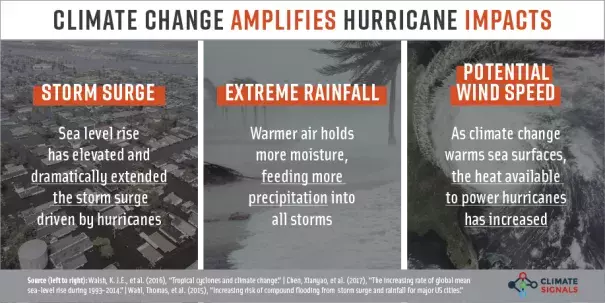[INFOGRAPHIC] Climate Change Amplifies Hurricane Impacts

Storm surge
Increases in storm surge related to climate change can be due to both rising seas and increasing storm wind speeds.[1]
Climate change has already contributed about 8 inches (0.19 meters) to global sea level rise, and this has dramatically amplified the impact of cyclones by increasing baseline elevations for waves and storm surge.[2][3][4][5] A small vertical increase in sea level can translate into a very large increase in horizontal reach by storm surge depending upon local topography. For example, sea level rise extended the reach of Hurricane Sandy by 27 square miles, affecting 83,000 additional individuals living in New Jersey and New York City[3] and adding over $2 billion in storm damage.[5] Aided by sea level rise, Hurricane Matthew set several storm tide records during its approach to the eastern sea board.
Extreme rainfall
Climate change is fueling extreme rainfall and dramatically increasing rainfall across many types of storms.[6][7] Estimates of the impact have been calculated for individual hurricanes (Katrina and Ivan),[7] and an increase in rainfall rates is one of the more confident predictions of the effects of climate change on tropical cyclones.[1]
Potential wind speed
The warmer the waters, the more energy there is available, increasing the risk of major hurricane development.[1] Like elected officials setting highway speed limits, water temperatures set maximum speed limits for hurricanes. In a warmer ocean, hurricanes can reach greater intensities with stronger winds (though they won’t always do so) because there is more energy available to them. And the faster a hurricane’s wind speeds, the higher its category.
There has been a global increase in the observed intensity of the strongest storms over recent decades.[8][9] The fingerprint of global warming in the intensity of tropical cyclones has been identified in one ocean basin: the Northwest Pacific.[10]


